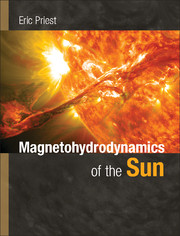Book contents
- Frontmatter
- Dedication
- Contents
- Preface
- 1 A Description of the Sun
- 2 The Basic Equations of Magnetohydrodynamics (MHD)
- 3 Magnetohydrostatics
- 4 Waves
- 5 Shock Waves
- 6 Magnetic Reconnection
- 7 Instability
- 8 Dynamo Theory
- 9 Magnetoconvection and Sunspots
- 10 Heating of the Upper Atmosphere
- 11 Prominences
- 12 Solar Flares and Coronal Mass Ejections
- 13 The Solar Wind
- Appendix 1 Units
- Appendix 2 Useful Values and Expressions
- References
- Index
13 - The Solar Wind
Published online by Cambridge University Press: 05 June 2014
- Frontmatter
- Dedication
- Contents
- Preface
- 1 A Description of the Sun
- 2 The Basic Equations of Magnetohydrodynamics (MHD)
- 3 Magnetohydrostatics
- 4 Waves
- 5 Shock Waves
- 6 Magnetic Reconnection
- 7 Instability
- 8 Dynamo Theory
- 9 Magnetoconvection and Sunspots
- 10 Heating of the Upper Atmosphere
- 11 Prominences
- 12 Solar Flares and Coronal Mass Ejections
- 13 The Solar Wind
- Appendix 1 Units
- Appendix 2 Useful Values and Expressions
- References
- Index
Summary
Variations in the Earth's magnetic field were first observed in the nineteenth century as a sudden increase (by about 10−3 G) followed by a slow decrease. These geomagnetic storms were sometimes found to occur one or two days after large solar flares (Carrington 1859), and further evidence for a link between the two phenomena came with the discovery of an 11-year periodicity in both flare and geomagnetic activity.
In the early 1900s Kristian Birkeland performed experiments to model an aurora produced by charged particles that he thought are ejected continuously from the Sun, but this idea was ignored by the scientific community. Then, Sydney Chapman (1929) suggested that geomagnetic storms are caused by streams of particles occasionally ejected from solar flares, and travelling at 1,000 km s−1 through the vacuum that was presumed to exist between the Sun and the Earth. Later, in order to explain the pointing of comet tails away from the Sun, Ludwig Biermann (1951) proposed, in agreement with Birkeland, that the Sun is emitting ‘solar corpuscles’ continuously rather than sporadically.
The first theory for an extended solar corona was by Chapman and Zirin (1957), who considered a static, spherically symmetric atmosphere and deduced that the corona extends to the Earth and beyond (Sec. 13.2). However, the difficulty with the model is that at large distances the pressure far exceeds any reasonable inter-stellar pressure and the density becomes indefinitely large.
- Type
- Chapter
- Information
- Magnetohydrodynamics of the Sun , pp. 451 - 482Publisher: Cambridge University PressPrint publication year: 2014



